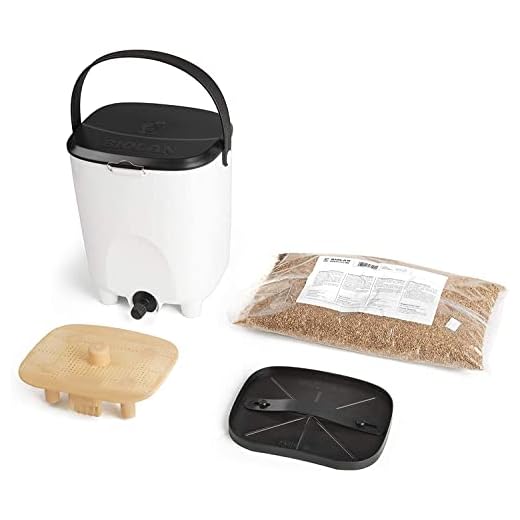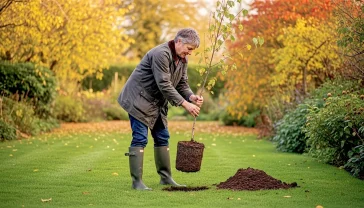The Ultimate Guide to Bokashi Bins: A Revolution in Your Kitchen
Discover Bokashi bins, the revolutionary kitchen composting system that handles all food waste—even meat and dairy. Our complete UK guide explains how it works.
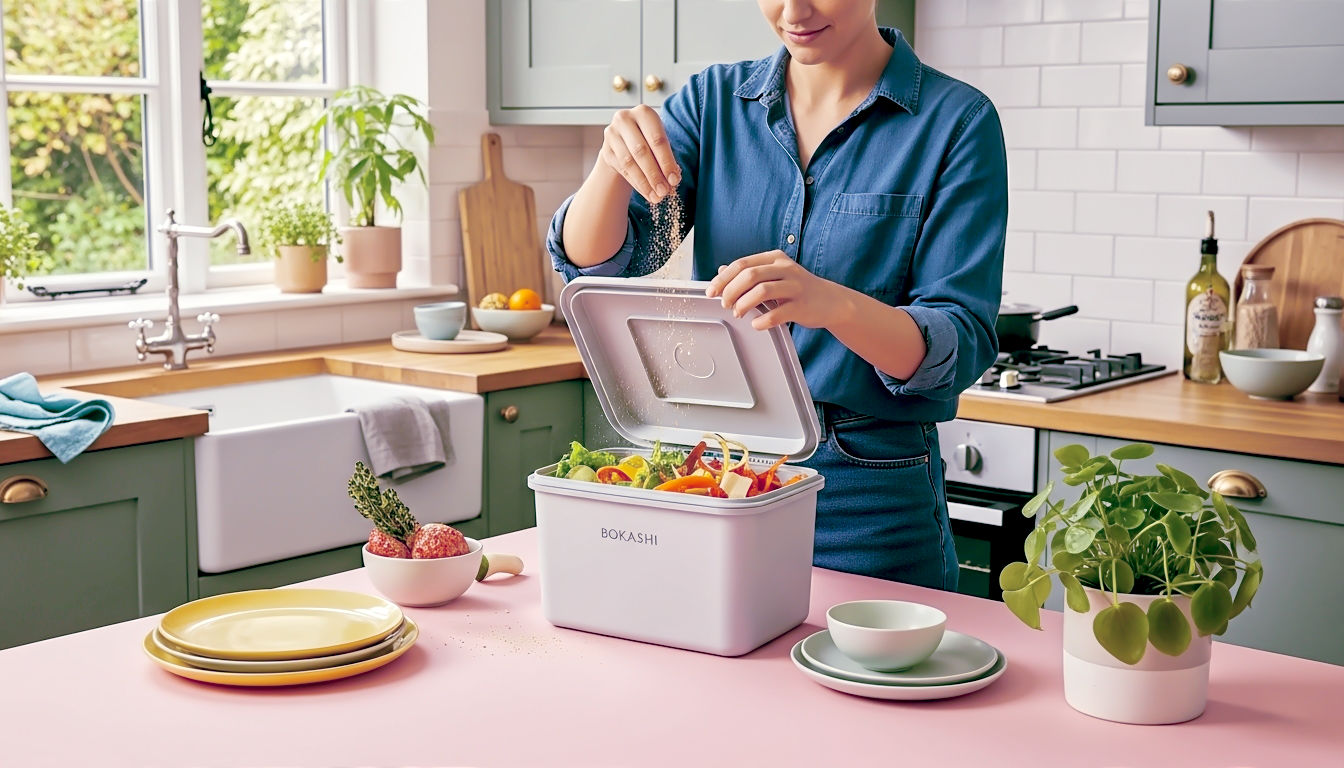
This post may contain affiliate links. If you make a purchase through these links, we may earn a commission at no additional cost to you.
Ever scrape leftovers into the bin and feel a pang of guilt? We’ve all been there. In Britain, we throw away a staggering amount of food waste every year. It feels wasteful, smells a bit grim by collection day, and we know it’s not great for the planet.
Many of us have tried composting. We’ve wrestled with big, clunky bins at the bottom of the garden, trying to get the right mix of green and brown stuff, only to end up with a slimy, smelly mess. And if you live in a flat or have a tiny patio, traditional composting is often a non-starter.
But what if there was a different way? A faster, easier, and less smelly method that could handle all your food scraps—even the tricky ones like meat, dairy, and cooked leftovers?
Meet the Bokashi bin.
This isn’t composting as you know it. It’s a clever, compact system that ferments your food waste right in your kitchen, using a special mix of microbes. Think of it like making sourdough or pickling onions, but for your scraps. It’s a quiet revolution happening in kitchens across the UK, from terraced houses in Manchester to city-centre flats in London.
This guide will tell you everything you need to know. We’ll dive into what Bokashi is, how it works, and why it might just be the perfect solution for your home. Forget everything you thought you knew about food waste. Let’s get started.
What on Earth Is a Bokashi Bin?
At first glance, a Bokashi bin looks like a simple plastic caddy. It’s usually a neat, rectangular bucket with a tight-fitting lid and, crucially, a little tap at the bottom. But the real magic isn’t the bin itself; it’s what happens inside.
The word “Bokashi” is Japanese for “fermented organic matter.” Unlike traditional composting, which relies on decomposition (letting things rot), Bokashi is an anaerobic process. This means it works without oxygen.
Here’s the simple breakdown:
- You add your food scraps to the bin. And we mean everything: fruit and veg peels, leftover curry, cheese rinds, chicken bones, fish skins, tea bags, coffee grounds—the lot.
- You sprinkle on some ‘Bokashi bran’. This is the secret ingredient. It’s a dry mix, usually wheat bran or sawdust, that has been inoculated with a special blend of microbes (more on those later!).
- You press it down and seal the lid. This squeezes out the air, creating the oxygen-free environment the microbes love.
You repeat this process until the bin is full. Then, you leave it sealed for a couple of weeks to let the fermentation work its magic. During this time, the microbes get to work, essentially pickling your food waste. It doesn’t break down into soil-like compost at this stage. Instead, it becomes ‘pre-compost’—a nutrient-rich, fermented material that’s ready for the final step.
Think of it this way: traditional composting is like leaving an apple on the side to slowly rot and turn brown. Bokashi is more like putting that apple in a jar with some spices to pickle it. The apple stays recognisable but is completely transformed.
The Bokashi System: What You Actually Need
Getting started is surprisingly simple. A typical Bokashi starter kit comes with everything you need:
- Two Bokashi Bins: Why two? So you can fill one while the other is fermenting. It keeps the process continuous.
- Bokashi Bran: A bag of the special microbe-infused bran.
- A Presser: A little tool to compact the waste and squeeze out air.
- A Scoop: For measuring the bran.
- A Jug: To collect the liquid that drains from the tap.
That’s it. No complicated machinery, no turning forks, no fuss. It’s designed to sit neatly in your kitchen, utility room, or on a balcony.
How Does Bokashi Actually Work? The Science Bit, Made Simple
Okay, let’s look under the lid. How does a sprinkle of bran turn a bucket of scraps into something amazing for your garden? It’s all down to a team of microscopic superheroes called Effective Microorganisms (EM).
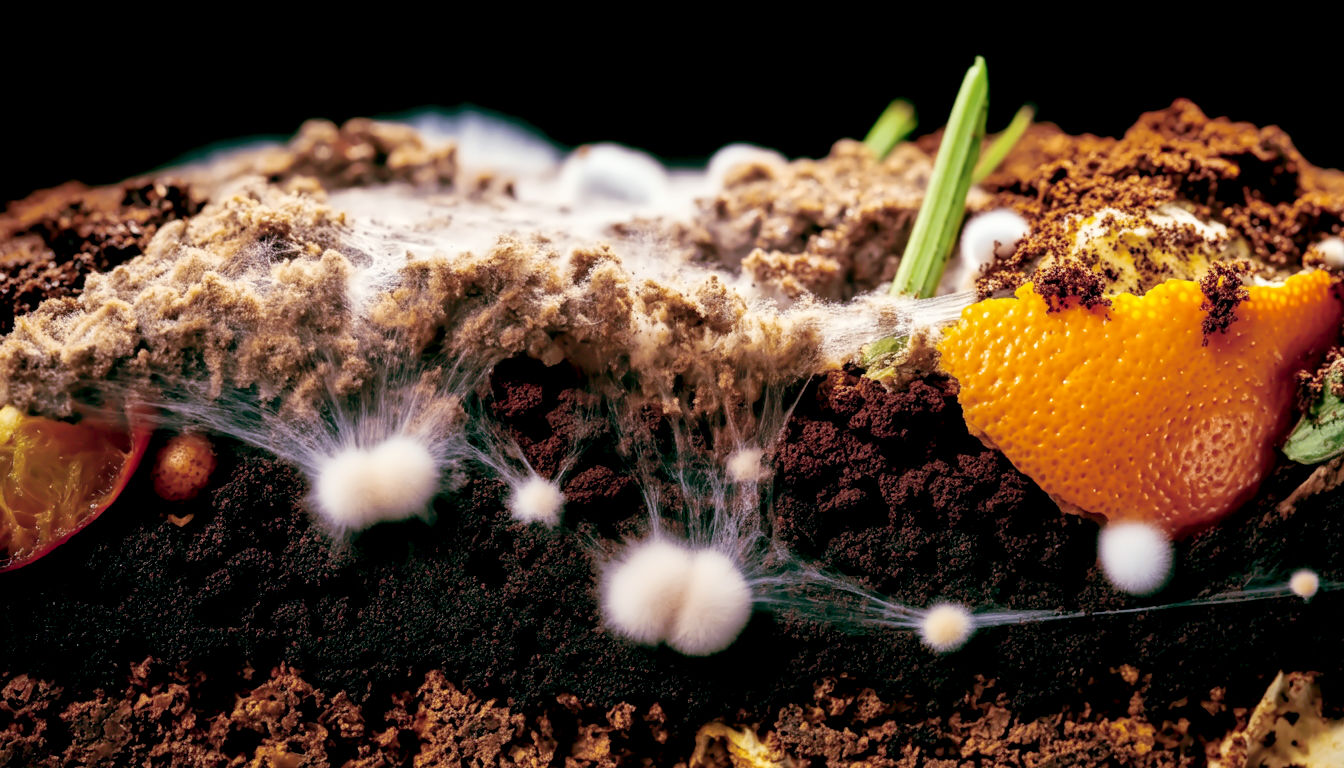
This term was coined by a Japanese professor, Dr. Teruo Higa, in the 1980s. He discovered that a specific blend of naturally occurring microbes could work together to create a powerful fermenting force.
The main players in the Bokashi bran are:
- Lactic Acid Bacteria: These are the same friendly bacteria found in yoghurt and sourdough bread. They are the workhorses of the Bokashi process, breaking down sugars and starches and producing lactic acid. This acid preserves the waste, preventing it from rotting and neutralising bad smells.
- Yeast: Just like the yeast that makes your bread rise or ferments your beer, these microbes produce vitamins and other beneficial substances that feed the other microorganisms.
- Photosynthetic Bacteria: These clever microbes can work in the dark, helping to break down tougher materials and eliminate gases like hydrogen sulphide (the one that smells like rotten eggs).
From Scraps to Pre-Compost: A Step-by-Step Journey
So, what happens when you add your scraps and bran to the bin?
- The Feast Begins: As soon as you add the bran, the microbes wake up and start feasting on the sugars and starches in your food waste.
- No-Oxygen Party: Because you’ve sealed the lid and compacted the waste, there’s very little oxygen. This is crucial. In an oxygen-rich environment, different microbes would take over—the ones that cause rotting, mould, and foul smells. But in the anaerobic Bokashi bin, the EM team thrives.
- The Pickling Process: The lactic acid bacteria get to work, producing lactic acid. This lowers the pH of the environment inside the bin, making it acidic. This acidity is what ‘pickles’ the waste. It preserves all the valuable nutrients and stops pathogens (the bad guys) from growing.
- Nutrient Preservation: In traditional composting, the heat generated causes nutrients like nitrogen and carbon to be lost as gases (ammonia and carbon dioxide). Because Bokashi is a ‘cold’ process, all those amazing nutrients are locked into the fermented waste, ready to be delivered to your garden.
After two to three weeks of fermentation, the contents of your bin will look surprisingly similar to what you put in. The banana peel will still look like a banana peel. But its cellular structure has been completely changed. It’s now ready to break down incredibly quickly once it’s introduced to soil.
What About the Smell?
This is the number one question people ask. And it’s a fair one, especially for a bin that lives in your kitchen.
A correctly managed Bokashi bin does not smell bad. It has a distinctive sweet-and-sour, slightly tangy aroma, a bit like pickles or cider vinegar. It’s certainly not the foul, rotting smell of a normal food waste bin. If your Bokashi bin starts to smell genuinely unpleasant (like ammonia or vomit), it’s a sign that something has gone wrong—usually that air has got in or you haven’t added enough bran.
The Bokashi Story: From Japanese Farms to British Kitchens
Bokashi feels like a modern invention, but its roots are ancient. For centuries, farmers across Asia, particularly in Korea and Japan, have used natural fermentation methods to improve their soil. They would create fermented fertilisers using local materials like rice bran, oil cake, and fishmeal, harnessing the power of native microorganisms.
The modern Bokashi system, however, was born out of the work of Dr. Teruo Higa at the University of the Ryukyus in Okinawa, Japan. In the 1980s, he was researching alternatives to chemical fertilisers and pesticides. He began experimenting with different combinations of microorganisms, looking for a blend that could work together to suppress soil-borne pathogens and improve crop health.
Initially, he worked with individual strains of microbes, but he wasn’t having much success. The story goes that one day, rather than dispose of his separate microbial cultures down different drains, he decided to save money by pouring them all into one bucket before throwing them away. A few days later, he noticed a significant improvement in the patch of grass where he’d dumped the mixed culture. The microbes were working together!
This led him to develop his specific cocktail of microorganisms, which he named Effective Microorganisms (EM). He found that this combination of lactic acid bacteria, yeast, and phototrophic bacteria created a regenerative, synergistic effect.
From Farm to Kitchen Caddy
Dr. Higa’s primary focus was large-scale agriculture. But it didn’t take long for people to realise that the same principles could be applied to household food waste. The idea of using the EM-infused bran in a sealed kitchen bin was a game-changer. It took a powerful agricultural technique and scaled it down for domestic use.
The system started to gain popularity in Japan and then spread globally. It arrived in the UK as a niche product for keen gardeners and environmentalists. But in recent years, with growing awareness of food waste and the climate crisis, Bokashi has entered the mainstream. Councils across Britain are facing challenges with food waste collection, and more and more people are looking for practical, at-home solutions.
For a nation of gardeners living on an island with limited landfill space, the Bokashi bin offers a beautifully simple and effective solution. It fits the British mindset of practicality, thrift, and making the most of what you’ve got.
Why Choose Bokashi? The Benefits for You and Your Garden
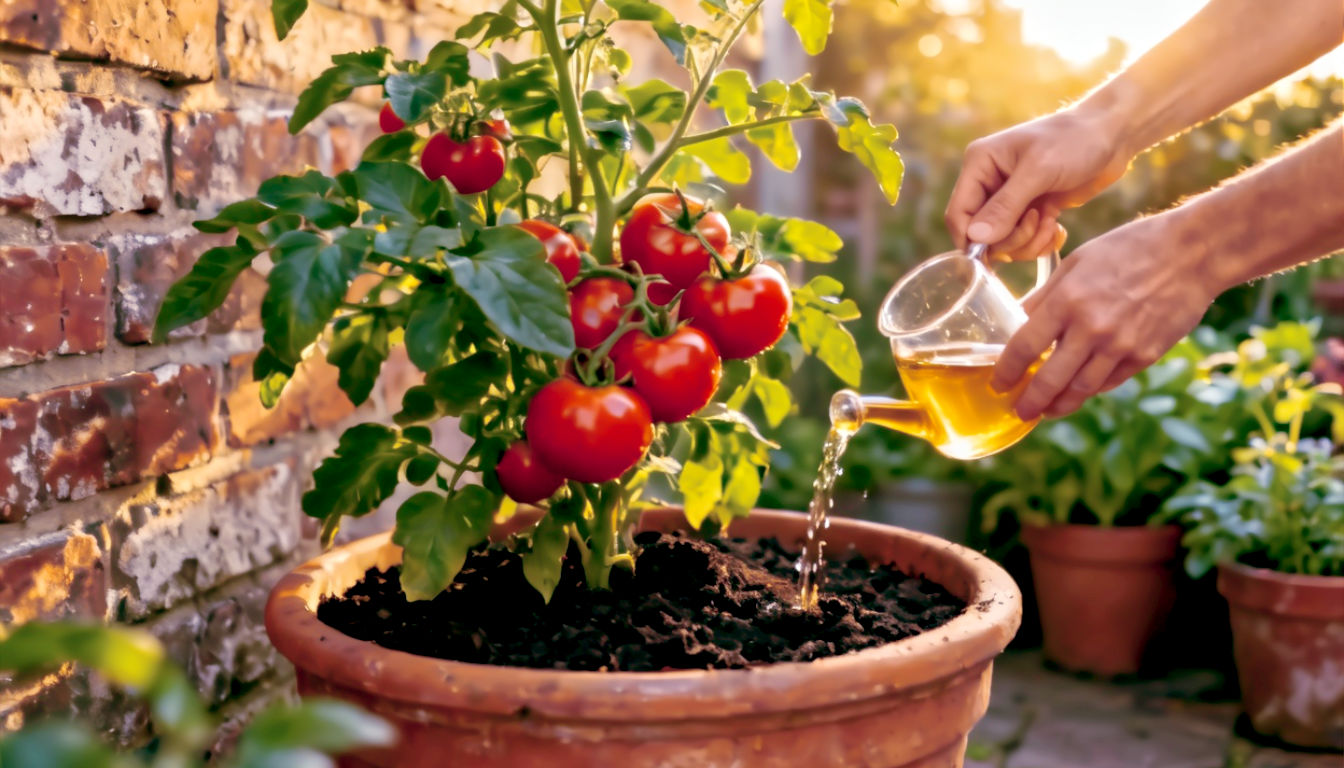
So, why go to the trouble of fermenting your food waste? The benefits are huge, both for you and for the planet.
1. It Takes Everything
This is the big one. Traditional compost heaps are fussy. You can’t add:
- Cooked food
- Meat, fish, and bones
- Dairy products like cheese and yoghurt
- Oily or greasy foods
These items attract pests like rats, create horrible smells, and can harbour harmful bacteria. But a Bokashi bin can handle it all. Because the process is anaerobic and acidic, pests aren’t interested, and pathogens are neutralised. This means 100% of your food waste can be recycled, dramatically reducing what goes into your general waste bin.
2. It’s Super Fast
A traditional compost heap can take anywhere from 6 to 12 months to produce usable compost. The Bokashi process is lightning-fast in comparison.
- Filling the bin: 1-2 weeks for an average family.
- Fermentation: 2 weeks.
- Breaking down in the soil: 2-4 weeks.
You can have nutrient-rich soil ready for planting in just over a month.
3. It’s Perfect for Any Size Home
Don’t have a garden? Live in a top-floor flat? No problem. The Bokashi bin itself is small enough to fit in any kitchen. The fermented pre-compost can be buried in pots on a balcony, donated to a friend’s allotment, or taken to a community garden. Its compact, sealed design makes it a viable option for urban dwellers who could never manage a traditional compost bin.
4. It Creates Two Amazing Garden Products
The Bokashi process gives you not one, but two fantastic outputs for your garden.
Product 1: The Fermented Pre-Compost
This is the solid matter left in the bin after fermentation. It’s a powerhouse of nutrients, microbes, and organic matter. When you bury it in your garden soil or add it to a compost heap, the native soil microbes go into a feeding frenzy. It breaks down incredibly quickly, releasing a huge boost of goodness that enriches the soil structure and feeds your plants.
Product 2: Bokashi ‘Tea’
As the food scraps are pressed down, they release liquid. This liquid drains to the bottom of the bin and is collected from the tap. This isn’t just smelly bin juice; it’s a potent, nutrient-rich liquid fertiliser, often called Bokashi tea.
You need to dilute it significantly with water (usually at a 1:100 ratio) before using it to feed your houseplants, window boxes, or garden vegetables. It’s packed with nutrients and beneficial microbes, giving your plants a fantastic boost. You can even pour it undiluted down your drains to help keep them clean and odour-free!
5. It’s Better for the Climate
When food waste rots in landfill, it releases methane, a greenhouse gas that is far more potent than carbon dioxide. Traditional composting also releases greenhouse gases. Because the Bokashi system is sealed and anaerobic, it prevents your food waste from rotting. The carbon and nitrogen are retained in the pre-compost, ready to be sequestered in your garden soil. It’s a small but powerful way to reduce your personal carbon footprint.
Your Step-by-Step Guide to Using a Bokashi Bin
Ready to give it a go? Here’s a simple, practical guide to getting started with your Bokashi system.
Step 1: Setting Up Your Bin
Find a good spot for your bin. The kitchen is ideal for convenience, but a utility room, garage, or sheltered balcony also works. The key is to keep it out of direct sunlight, as extreme temperature changes can affect the fermentation process. Make sure the tap is fully closed!
Step 2: Adding Your First Scraps
Start adding your food waste. It’s best to chop up larger items like cabbage cores or bread crusts into smaller pieces (about the size of a golf ball). This creates more surface area for the microbes to work on.
For your first layer, it’s good to put in something absorbent like a piece of kitchen roll or a slice of bread to soak up any initial moisture.
Step 3: Sprinkling the Magic Bran
After adding a layer of scraps (about 1-2 inches deep), it’s time for the bran. Sprinkle a small handful (about 20ml or a tablespoon) evenly over the surface.
Top Tip: Be more generous with the bran when adding high-protein foods like meat, fish, or cheese. These need a bit more help to ferment properly. You can’t really ‘overdose’ on the bran, so it’s better to add a little too much than not enough.
Step 4: Pressing It Down
Use the pressing tool to compact the layer of waste firmly. This is a crucial step. You’re trying to squeeze out as much air as possible to help create that all-important anaerobic environment.
Step 5: Sealing the Lid
Close the lid and make sure it’s sealed tightly. And that’s it for today!
Step 6: Repeat Until Full
Continue this process—scraps, bran, press, seal—every time you have waste to add. Try not to open the bin too often. It’s better to collect your scraps in a caddy throughout the day and add them all in one go in the evening. This minimises the bin’s exposure to air.
Step 7: Draining the Bokashi Tea
After a few days, you’ll be able to start draining the liquid fertiliser from the tap. Do this every 2-3 days. It’s important not to let the liquid build up, as it can make the contents too wet and cause them to rot.
Remember to dilute the tea (1:100 is a good starting point) before feeding your plants.
Step 8: The Fermentation Holiday
Once your bin is full, press down the final layer firmly, add a generous sprinkle of bran, and seal the lid. Now, you leave it alone for at least two weeks.
Put it somewhere out of the way and start filling your second bin. This two-week period is when the main fermentation happens, and the microbes work their magic.
Step 9: Using the Final Product
After two weeks, your pre-compost is ready. When you open the lid, you should see a layer of white mould on the surface. This is a great sign! It’s a type of yeast and shows that the fermentation has been successful. Black or green mould is a bad sign (see troubleshooting below).
The contents will look much like they did when you put them in, but they will have that distinctive sweet-and-sour pickle smell.
Now, what do you do with it? You have a few options.
Option 1: The Soil Factory
This is a great method if you have some outdoor space. You’ll need a large container with a lid, like a dustbin or a large plastic storage box.
- Drill some drainage holes in the bottom of the container.
- Put a 4-inch layer of garden soil or old compost in the bottom.
- Empty your Bokashi pre-compost into the container and mix it with more soil. Aim for a ratio of about one part Bokashi to two parts soil.
- Cover the mix with a final layer of soil and put the lid on.
- Leave it for 2-4 weeks. When you open it, you’ll find beautiful, rich, dark compost, ready for your pots and garden beds.
Option 2: Trench Method
Simply dig a trench in your garden or allotment bed, about a spade’s depth. Empty the Bokashi pre-compost into the trench, mix it with some soil, and then cover it with the remaining soil.
Important: The fermented pre-compost is acidic, so you must leave it for at least two weeks before planting anything directly on top of it. This gives the pH time to neutralise.
Option 3: Supercharge Your Compost Heap
If you already have a traditional compost bin, you can add your Bokashi pre-compost directly to it. It will act as a powerful accelerator, adding a massive injection of nutrients and beneficial microbes that will speed up the entire decomposition process.
Option 4: For the Balcony Gardener
If you only have pots, you can still use the Bokashi pre-compost.
- Take a large pot and fill the bottom third with soil or used potting mix.
- Add a layer of your Bokashi pre-compost.
- Cover with another thick layer of soil.
- Leave it for two weeks before planting anything in the pot.
Common Problems and Troubleshooting
Bokashi is pretty foolproof, but occasionally things can go wrong. Here are the most common issues and how to fix them.
| Problem | Likely Cause | Solution |
|---|---|---|
| It smells really bad (like rotting bins) | Too much air getting in, not enough bran, or the contents are too wet. | Add a generous handful of extra bran and mix it in. Ensure the lid is sealed tightly. Drain the liquid more frequently. |
| I’m seeing black or green mould | Air contamination. These are the moulds that cause rot. | Scrape off the affected layer and discard it. Add a thick layer of bran, press down firmly, and ensure the lid is properly sealed. |
| There’s no liquid coming from the tap | The food waste you’ve added is quite dry (e.g., lots of bread or pasta). | This is fine! The amount of tea depends on what you put in. Juicy fruits and vegetables will produce a lot more liquid. No liquid isn’t a sign of failure. |
| I see maggots in the bin! | A fly has managed to lay eggs on the waste before the lid was sealed. | This is rare with a properly sealed bin. Unfortunately, the bin is contaminated. It’s best to empty it (bury it deep in the garden or compost heap) and start again. |
Bokashi vs. Traditional Composting vs. Wormeries
How does Bokashi stack up against other popular home composting methods in the UK?
| Feature | Bokashi Bin | Traditional Compost Bin | Wormery (Vermicomposting) |
|---|---|---|---|
| What it can take | All food waste (meat, dairy, cooked food etc.) | Garden waste, raw fruit & veg scraps. No cooked food, meat, or dairy. | Raw fruit & veg scraps. No citrus, onions, meat, or dairy. |
| Speed | Very fast (usable in ~4-6 weeks) | Slow (6-12 months) | Medium (2-3 months) |
| Space Required | Very small (kitchen-sized) | Large (requires garden space) | Medium (can be used on a balcony or in a garage) |
| Smell | Tangy, pickle-like odour | Earthy smell (if managed well), can be smelly if not | Earthy smell |
| Outputs | Fermented pre-compost & liquid fertiliser | Soil-like compost | Worm castings (vermicompost) & liquid fertiliser (‘worm tea’) |
| Best for… | Anyone, especially flats and urban homes. | Homes with large gardens and lots of garden waste. | People who want high-quality compost for pots and don’t have much waste. |
The Future of Food Waste in Britain
As we become more aware of our impact on the planet, solutions like Bokashi are moving from the fringe to the forefront. Local councils across the UK are trialling new food waste collection schemes, but at-home solutions empower individuals to take direct control.
Bokashi isn’t just about reducing waste; it’s about creating a closed-loop system in your own home. It’s about turning something that was destined for landfill into a valuable resource that can enrich the soil, feed your plants, and help you grow your own food.
It’s a small change in your daily routine that can have a big impact. It connects you to the natural cycle of food, from plate to soil and back again. So next time you’re about to scrape those leftovers into the bin, maybe think about pickling them instead. Your garden will thank you for it.
Further Reading & Resources
For those looking to dive deeper, here are some highly respected UK-based resources:
- Garden Organic: The UK’s national charity for organic growing, with fantastic resources on composting and soil health. www.gardenorganic.org.uk
- Wiggly Wigglers: A Herefordshire-based company that are long-standing champions of Bokashi, wormeries, and other home composting systems in the UK. www.wigglywigglers.co.uk
- The Royal Horticultural Society (RHS): Provides expert advice on all aspects of gardening, including soil improvement and composting. www.rhs.org.uk
- TwoWests: Family business specialising in helping you to grow your own fruit and veg, naturally. Plenty of resources on all things composting. www.twowests.co.uk



